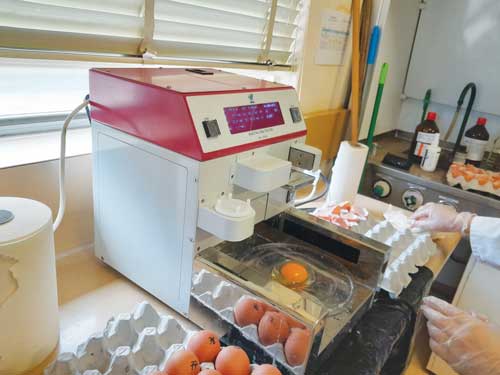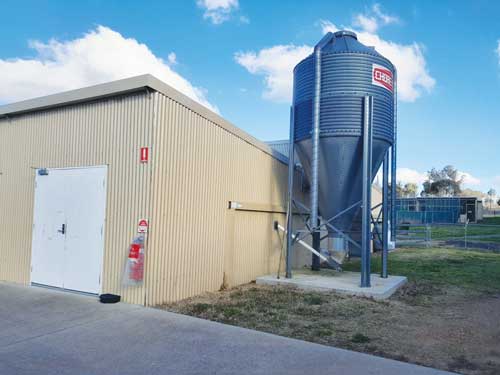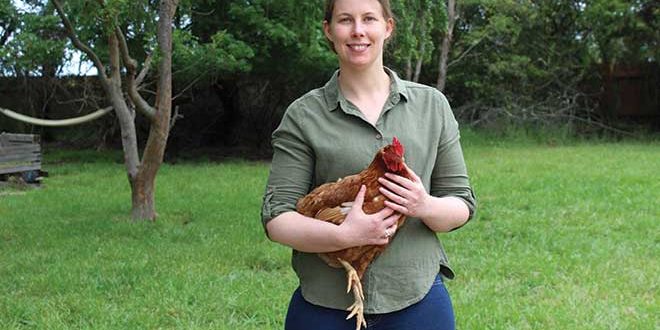ABOVE: Dr Amy Moss completed a study on the effect of AM/PM diets for free-range laying hens.
Nutrient requirements change gradually to meet an animal’s needs throughout growth.
However, the inherent assumption here is that there are no fluctuations within a day.
But is this the case?
To explore the nutrient requirements for laying hens, in conjunction with Poultry Hub Australia and Australian Eggs, Dr Moss, Dr Dao and team at the University of New England completed a study on the effect of AM/PM diets for free-range laying hens.
Laying hens have a cyclic reproductive physiology that requires high dietary protein and energy levels for yolk and albumen formation in the early morning and high dietary calcium levels for shell and membrane formation in the afternoon/evening.
Therefore, feeding one diet throughout each day may be problematic as there is excess calcium in the morning and excess protein/amino acids and energy towards the end of the day.

Figure 1: Feed conversion ratio (FCR, kg feed/kg egg mass) of hens offered control and AM/PM diets.
To minimise excess nutrients, there is increasing interest in alternative strategies, such as AM/PM feeding, where a high energy and protein diet with lower calcium is provided in the morning and a lower energy and protein diet with higher calcium is fed in the afternoon.
AM/PM feeding has previously been illustrated to improve feed efficiency and eggshell quality and reduce environmental pollution by minimising excess nutrient and allowing the capacity for the hens to sequentially select feed.
However, there are opportunities to investigate the potential effects of AM/PM diets on hen welfare, particularly feather pecking, and under an Australian free-range system.

Analysis of eggs in University of New England’s egg lab.
Therefore, an experiment was conducted at UNE’s free-range research facility, where two dietary treatments – a conventional layer hen diet (control) and AM/PM hen diets – were offered to nine replicate pens of 20 hens each, giving a total of 360 hens (18 pens) from 34 to 53 weeks of age.
Mash wheat-sorghum-soy based diets were used.
The control diet contained 11.6MJ/kg AMEn, 0.810 percent digestible lysine, and 4.1 percent calcium.
Hens offered the AM/PM diet received the AM diet (12.5MJ/kg AMEn, 0.900 percent digestible lysine, 2.5 percent calcium) from 8am to 4pm and the PM diet (10.8MJ/kg AMEn, 0.760 percent digestible lysine, 5.6 percent calcium) from 4pm to 8am.

Figure 2: Average range use (hours/day) of hens offered control and AM/PM diets.
Egg weight and egg production were measured daily, while feed consumption and feed conversion ratio were measured weekly.
Egg quality and bone quality were measured at week 53.
Additionally, hen behaviour was assessed from 49 to 50 weeks of age with camera recordings and individual ranging behaviour was monitored by radiofrequency identification technology from 39 to 48 weeks of age.
The results showed that AM/PM feeding improved laying hen performance by increasing egg mass by 2.15 percent (60.4 vs 59.1g/hen/day, P = 0.086) and improving feed efficiency by 8.34 percent (2.231 vs 2.436kg feed/kg egg, P < 0.05, see Figure 1) compared to the control feeding regime over 20 weeks of the study.

University of New England Laureldale Free Range poultry shed.
Hens offered the AM/PM diet also had a higher yolk colour score compared to the hens offered the control diet (12.3 vs 11.6, P < 0.01).
The amounts of pigments across all diets were the same, so this result was likely due to AM/PM hens spending longer on the range (2.85 vs 2.47 hours/day, P < 0.001, see Figure 2), which may mean they consumed more pigmented material such as insects and grass.
Hens on the AM/PM treatment also had higher tibia ash content (43.3 percent vs 41.6 percent, P < 0.05) and breaking strength (19.98kg vs 17.13kg of force, P < 0.05, see Figure 3), meaning that AM/PM hens may be less prone to bone fractures.
Furthermore, AM/PM hens were observed to feather-peck less frequently than the control hens (0.39 percent vs 1.15 percent, P = 0.01), possibly because their dietary needs were more closely met.

Figure 3: Bone breaking strength (Kgf) of hens offered control and AM/PM diets.
Thus, AM/PM diets had performance, skeletal health and possible welfare benefits.
Finally, we completed a cost-benefit analysis, which demonstrated that the feed cost per kilo of egg mass was approximately 20 percent less for AM/PM fed hens, or a saving of $0.012 per kilogram of eggs, compared to hens fed the control diet.
For a farm of 100,000 layers from 18 to 90 weeks of age, this equates to a total saving of roughly $30,000, which would probably justify the initial outlay of extra silos to set the AM/PM feeding system up.
We would like to acknowledge and thank Poultry Hub Australia and Australian Eggs for funding the project and guidance, encouragement and support.
For more information, contact Dr Moss on amoss22@une.edu.au
Amy Moss
University of New England

